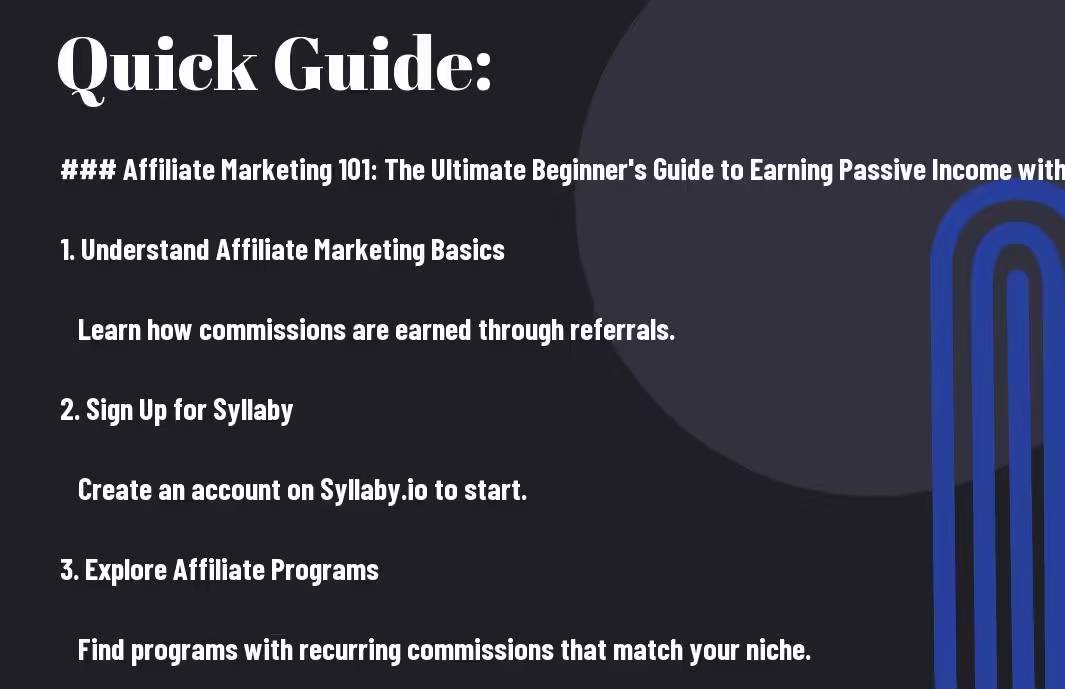I’m excited to share with you the world of affiliate marketing, a proven way to earn passive income online. As a beginner, I know it can seem overwhelming, but trust me, it’s worth it. With affiliate marketing, you can promote products you love and earn a commission for each sale made through your unique link. In this guide, I’ll walk you through the basics, show you how to find affiliate programs, and provide tips on promoting your links effectively. Plus, I’ll introduce you to Syllaby.io, a game-changing platform that can help you succeed in affiliate marketing. So, let’s get started on this journey to earning passive income together!
 Here is the text for the chapter “What is Affiliate Marketing?” :
Here is the text for the chapter “What is Affiliate Marketing?” :
What is Affiliate Marketing?
While affiliate marketing has become one of the most popular and accessible ways to earn passive income online, many people still don’t understand what it’s all about. As someone who’s interested in earning passive income, I want to break down the concept of affiliate marketing in simple terms.
Definition and Benefits
You might have heard of affiliate marketing, but do you know how it works? Essentially, affiliate marketing is commission-based sales. As an affiliate, I earn a percentage of sales that occur through my promotional efforts. The beauty of affiliate marketing lies in its simplicity and scalability. With the right tools and strategies, I can promote products or services and earn commissions without having to create my own products or handle customer support.
The most enticing part of affiliate marketing is its scalability. Many affiliate programs, especially subscription-based ones like Syllaby, offer recurring commissions. This means that once I get a customer to sign up for a service, I continue to earn commissions as long as they remain subscribed. It’s a passive income stream that can grow over time.
How it Works
On the surface, affiliate marketing seems straightforward. I promote a product or service, and when someone makes a purchase using my unique affiliate link, I earn a commission. But there’s more to it than that. A typical example would be signing up as an affiliate for Amazon or TikTok Shop. After getting approved, I receive a trackable link that I share across my platforms. When a customer clicks on my link and makes a purchase, the system records the sale and credits my commission, sometimes even if the sale occurs weeks later due to tracking mechanisms like cookies.
For instance, let’s say I promote a subscription-based service like Syllaby. If someone signs up for a monthly plan using my affiliate link, I earn a commission every month they remain subscribed. This means that my earnings can grow exponentially over time, without me having to put in extra effort.
Types of Affiliate Marketing
You can promote affiliate links through various channels, each with its unique advantages and audience engagement strategies. Understanding the different types of affiliate marketing is imperative to choosing the most effective approach for your content and audience.
Here’s a breakdown of the main types of affiliate marketing:
| Video Content | Platforms like YouTube, TikTok, and Instagram Reels |
| Social Media Posts | Text-based platforms such as Facebook and Twitter |
| Email Newsletters | Building an email list and sending targeted affiliate offers |
| Creating visually appealing pins and linking to affiliate pages | |
| Blogs and Websites | Inserting affiliate banners, writing reviews, or creating listicles |
Knowing which type of affiliate marketing to focus on will help you maximize your earnings and optimize your promotional strategy.
Video Content
Types of video content, such as tutorials, reviews, or unboxing videos, are perfect for promoting affiliate links. By creating engaging content and using tools like ManyChat, you can automatically send direct messages with your affiliate link to viewers who comment on your post, significantly increasing conversions.
For example, if you’re promoting a fitness program, you can create a workout tutorial video and include your affiliate link in the video description or comments section.
Social Media Posts
Even with the rise of video content, social media posts remain an effective way to promote affiliate links. It’s recommended to avoid posting links directly in the main content—especially on Facebook—since that can reduce your post’s visibility.
A better approach is to include the link in the comments section to maximize reach. You can also use social media scheduling tools to automate your posts and increase engagement.
A social media post promoting a product or service can be as simple as sharing a brief review or testimonial, accompanied by your affiliate link.
Email Newsletters
For affiliate marketers, building an email list can exponentially grow your earnings. Beehive is a fantastic tool for creating and monetizing newsletters.
You can insert affiliate links directly into your newsletter and send content to your subscribers regularly, ensuring consistent engagement. It’s imperative to segment your email list and tailor your content to specific groups for better results.
It’s also important to comply with email marketing regulations, such as GDPR and CAN-SPAM, to avoid penalties and maintain a positive sender reputation.
Now, you might be thinking, “Pinterest? Isn’t that just for DIY enthusiasts and fashion bloggers?” Not quite. Pinterest can be a goldmine for affiliate marketing, especially if you’re promoting products or services with visually appealing images.
To drive traffic from Pinterest, create boards and pins around the products or services you’re promoting, and link them to your affiliate page. You can also use Pinterest’s shopping feature to tag products directly in your pins.
To increase engagement, make sure to optimize your pins with relevant keywords and descriptions, and use high-quality images that showcase the product or service.
Blogs and Websites
Even if you don’t have a massive audience, affiliate marketing is an excellent way to monetize traffic from your blog or website. You can insert affiliate banners, write reviews, or create listicles that incorporate affiliate links.
Newsletters can also be used to promote affiliate links to your website visitors. By building an email list and sending targeted content, you can increase conversions and earn more commissions.

Tips for Promoting Affiliate Links
For a successful affiliate marketing strategy, it’s crucial to promote your affiliate links effectively. Here are some tips to help you get started:
- Choose the right platform for your content, whether it’s video, social media, email newsletters, or blogs.
- Create engaging content that resonates with your audience and encourages them to click on your affiliate link.
- Use tools like ManyChat and Beehive to automate and optimize your promotional efforts.
- Maximize your reach on social media by posting at the right times, using relevant hashtags, and engaging with your audience.
Creating Engaging Content
Now that you have your affiliate link, it’s time to create content that drives conversions. Here are some tips to help you create engaging content:
When creating content, focus on providing value to your audience. Whether it’s through educational videos, informative blog posts, or entertaining social media posts, make sure your content is relevant, informative, and engaging. This will encourage your audience to click on your affiliate link and increase your chances of earning commissions.
Additionally, make sure your content is optimized for conversions. Use attention-grabbing headlines, include clear calls-to-action, and make it easy for your audience to click on your affiliate link.
Using Tools like ManyChat and Beehive
Assuming you have created engaging content, the next step is to promote it effectively. This is where tools like ManyChat and Beehive come in.
ManyChat is a powerful tool that allows you to automate and optimize your promotional efforts. With ManyChat, you can create chatbots that send direct messages to your audience, increasing conversions and earnings. Additionally, ManyChat provides detailed analytics, allowing you to track your performance and make data-driven decisions.
ManyChat is an excellent tool for promoting affiliate links. By creating automated chatbots, you can send targeted messages to your audience, increasing the chances of conversions. For example, you can create a chatbot that sends a direct message to users who comment on your video, including your affiliate link and a clear call-to-action.
Maximizing Reach on Social Media
Engaging with your audience on social media is crucial for promoting affiliate links. Here are some tips to help you maximize your reach:
When posting on social media, make sure to post at the right times, when your audience is most active. Use relevant hashtags to increase your reach and engage with your audience by responding to comments and direct messages.
Plus, use social media analytics tools to track your performance and make data-driven decisions. This will help you identify what’s working and what’s not, allowing you to optimize your promotional efforts and increase earnings.

Step-by-Step Guide to Building a Successful Affiliate Marketing Funnel
Your affiliate marketing funnel is the backbone of your promotional strategy. It’s where you guide potential buyers through a series of touchpoints, increasing their chances of conversion. A well-structured funnel can make all the difference between a successful affiliate marketer and one who struggles to earn commissions.
| Funnel Step | Description |
|---|---|
| Awareness | Create engaging social media posts, videos, or blog content that grabs the attention of potential buyers. |
| Interest | Direct users to your email newsletter or a landing page with more in-depth content, building their interest in the product or service. |
| Desire | Send targeted affiliate offers via email or create persuasive content that highlights the benefits of the product or service. |
| Action | Encourage users to make a purchase using your unique affiliate link, providing a seamless buying experience. |
Creating a Well-Structured Funnel
Now that you have a basic understanding of the funnel steps, it’s time to create a well-structured funnel that resonates with your target audience. Start by identifying your niche and the products or services you want to promote. Then, create content that speaks to your audience’s pain points, interests, or desires.
As you build your funnel, ensure each step flows seamlessly into the next, providing a cohesive experience for potential buyers. Use tools like Syllaby to simplify content creation, and focus on promoting your affiliate links across various platforms.
Converting Clicks into Sales
Clearly, converting clicks into sales is the ultimate goal of affiliate marketing. To achieve this, you need to understand your target audience’s buying behavior, preferences, and pain points. Create content that addresses these factors, increasing the likelihood of conversion.
This is where tracking and analyzing your funnel performance becomes crucial. Use tools like Syllaby to monitor your clicks, conversions, and earnings, identifying areas for improvement and optimizing your funnel accordingly.
This optimization process is ongoing, and it’s necessary to stay up-to-date with industry trends, consumer behavior, and affiliate program changes to ensure your funnel remains effective. By continuously refining your approach, you’ll increase your chances of converting clicks into sales and earning passive income through affiliate marketing.
Factors to Consider for Success in Affiliate Marketing
Keep in mind that success in affiliate marketing doesn’t happen overnight. It requires dedication, persistence, and a well-thought-out strategy. To increase your chances of success, consider the following key factors:
- Consistency: Regularly posting high-quality content and promoting your affiliate links is vital to building trust with your audience and driving sales.
- Patient persistence: Affiliate marketing is a long-term game. Don’t expect immediate results and be prepared to put in the effort required to build a loyal following.
- Strategic approach: Understand your target audience, choose relevant products, and create content that resonates with them.
- Relevant tools and resources: Leverage platforms like Syllaby, Beehive, and ClickBank to streamline your affiliate marketing efforts and stay organized.
If you’re new to affiliate marketing, I recommend checking out Passive income through affiliate marketing: the beginner’s guide to get a better understanding of the industry. After all, knowledge is power, and the more you know, the better equipped you’ll be to succeed.
Consistency and Patience
While it’s tempting to expect overnight success, affiliate marketing requires a long-term commitment. You need to consistently create high-quality content, engage with your audience, and promote your affiliate links to build trust and drive sales. Be patient, and don’t get discouraged by initial setbacks or slow progress.
Keep in mind, every successful affiliate marketer started from scratch. Focus on building a loyal following, and with time, your affiliate income will grow. Consistency and patience are key to achieving success in affiliate marketing.
Strategic Approach
Consider your target audience, their needs, and preferences when choosing products to promote. A strategic approach involves understanding your niche, selecting relevant products, and creating content that resonates with your audience. This increases the likelihood of driving sales and earning commissions.
Factors such as the product’s quality, pricing, and commission rates all play a role in your strategic approach. By taking a thoughtful and targeted approach, you’ll be more likely to succeed in affiliate marketing.
Factors like consistency, patience, and a strategic approach are vital to achieving success in affiliate marketing. By keeping these factors in mind, you’ll be well on your way to building a successful affiliate marketing business and earning passive income online.
Pros and Cons of Affiliate Marketing
Not every business model is perfect, and affiliate marketing is no exception. While it offers a wealth of opportunities, it’s important to understand both the advantages and disadvantages to make informed decisions.
| Pros | Cons |
|---|---|
| Passive income potential | Competition from other affiliates |
| Low startup costs | Rejection or denial from affiliate programs |
| Flexibility in promoting products | Tracking and managing affiliate links |
| Opportunity to promote products you love | Building trust with your audience |
| Scalability and recurring commissions | Federal Trade Commission (FTC) compliance |
| Minimal risk involved | Dealing with refunds or customer complaints |
| Access to a wide range of products and services | Staying up-to-date with affiliate program changes |
Scalability and Accessibility
Scalability is one of the most significant advantages of affiliate marketing. With the right strategies and tools, your earnings can grow exponentially over time. Platforms like Syllaby offer recurring commissions, allowing you to earn passive income from a single sale. This scalability makes affiliate marketing an attractive option for those looking to monetize their online presence.
Moreover, affiliate marketing is highly accessible. You don’t need an existing audience or a massive following to get started. With the right content and promotional strategies, anyone can succeed in affiliate marketing.
Potential Drawbacks
Affiliate marketing isn’t without its challenges. One of the most significant drawbacks is the potential for rejection or denial from affiliate programs. This can be frustrating, especially if you’ve invested time and effort into promoting a product.
Additionally, building trust with your audience is crucial in affiliate marketing. If your audience doesn’t trust your recommendations, they’re unlikely to make a purchase through your affiliate link.
Accessibility can also be a double-edged sword. While it’s easy to get started with affiliate marketing, it also means that competition can be fierce. You’ll need to differentiate yourself and provide unique value to stand out from the crowd.
Summing up
Upon reflecting on my journey through Affiliate Marketing 101, I realize that this comprehensive guide has equipped me with the knowledge and tools necessary to succeed in the world of affiliate marketing. From understanding the basics of affiliate marketing to finding and joining affiliate programs, promoting affiliate links, and building a successful affiliate marketing funnel, I now have a clear roadmap to earning passive income online.
With platforms like Syllaby, Beehive, and directories like ClickBank, I’m excited to start exploring the numerous opportunities available in affiliate marketing. I’m confident that by applying the strategies and techniques outlined in this guide, I’ll be able to create a lucrative affiliate marketing business that generates consistent income. If you’re looking to do the same, I encourage you to take the first step today and start your affiliate marketing journey with Syllaby.io.
FAQ
Q: What is Affiliate Marketing and How Does it Work?
A: Affiliate marketing is a performance-based marketing model where affiliates earn a commission by promoting a company’s products or services. As an affiliate, you earn a percentage of sales that occur through your promotional efforts. You promote a product or service, and when someone makes a purchase using your unique affiliate link, you earn a commission. It’s a straightforward, one-tier system that rewards you for driving sales.
Q: How Do I Find Affiliate Programs and Get Started?
A: Affiliate programs are easy to find and often free to join. Most websites offering affiliate programs have a dedicated section—usually in the footer—labeled as “Affiliate Program” or “Partners.” You can also use platforms like ClickBank and FastPedia to find affiliate programs across various industries. Once you’ve found programs that fit your niche, sign up, get your unique affiliate link, and start promoting it through the best channels available to you.
Q: What are the Best Ways to Promote Affiliate Links?
A: There are numerous ways to promote affiliate links, each tailored to different types of content creators. You can use video content on platforms like YouTube, TikTok, and Instagram Reels, social media posts on Facebook and Twitter, email newsletters using tools like Beehive, Pinterest, and blogs or websites. The key is to find the channels that work best for you and your audience.
Q: How Do I Build a Successful Affiliate Marketing Funnel?
A: A well-structured affiliate marketing funnel is crucial for converting clicks into sales. Your funnel could include a combination of video, text posts, and email marketing, ensuring multiple touchpoints with potential buyers. Start with engaging social media posts, direct users to your email newsletter for more in-depth content, and then send them targeted affiliate offers via email. Consistency and strategy are key to building a successful affiliate marketing funnel.
Q: Why is Syllaby a Great Platform for Affiliate Marketers?
A: Syllaby is an ideal platform for affiliate marketers because it offers a comprehensive 5-in-1 tool that simplifies the content creation process. With Syllaby, you can find trending topics, write high-converting scripts, generate faceless or avatar-based videos, and even schedule and track your posts—all from one platform. Plus, Syllaby’s affiliate program offers recurring commissions, ensuring you earn every time your referral makes a payment. Its AI-driven features and vast resource library make it the perfect tool for affiliates looking to grow and scale their marketing efforts.
















